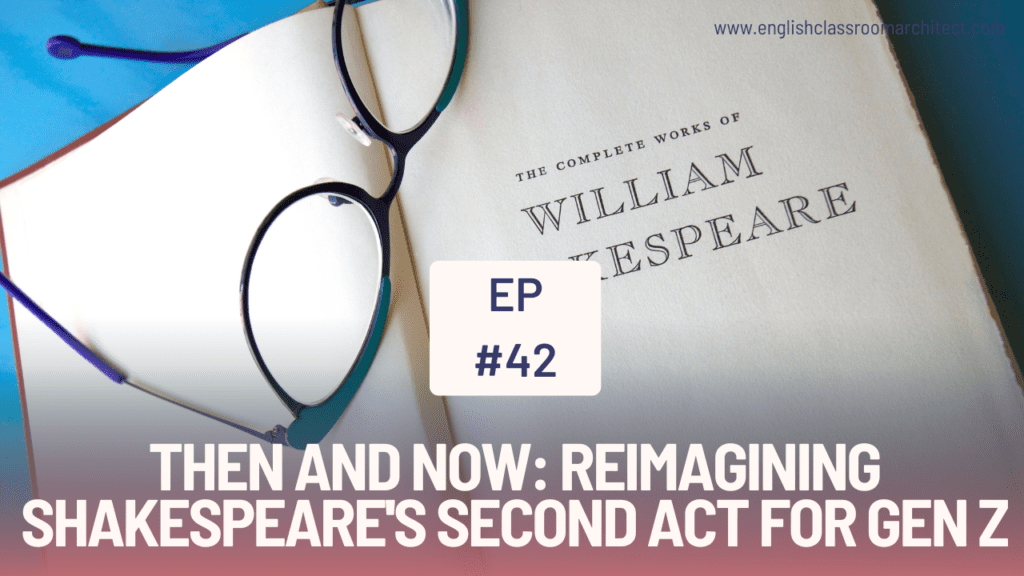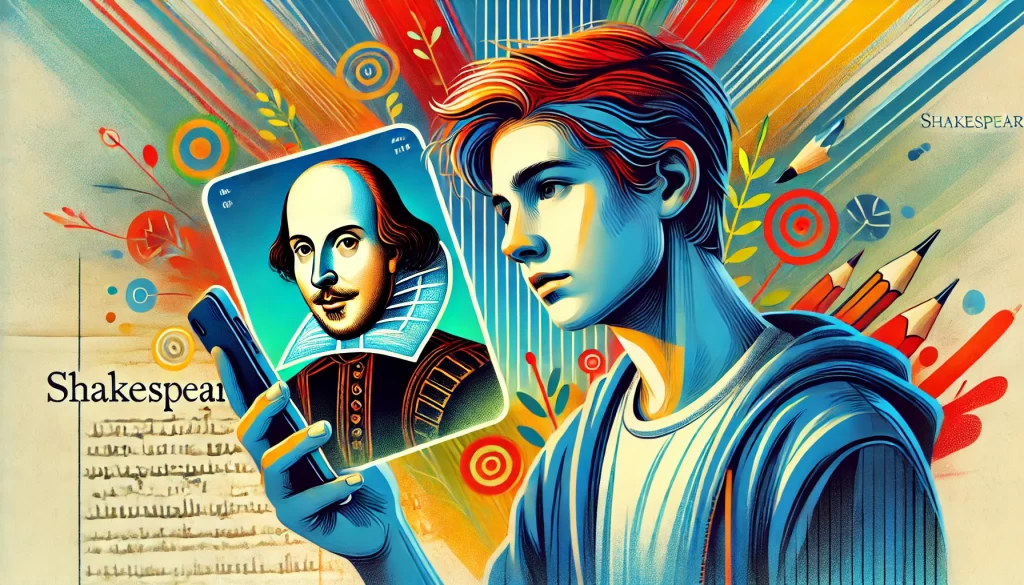
Episode Description
How can a 400-year-old play compete with TikTok for your students’ attention? In this episode, we’re exploring unexpected connections between Shakespeare’s timeless works and modern digital culture. We’ll discuss how thinking outside the script can transform both student engagement and your approach to teaching classic literature.
You’ll discover:
- Applying social media strategies for reimagining Shakespeare
- Parallels between historical context and contemporary relevance
- Reframing our role as ‘digital storytellers’ in literature education
- Practical ways to implement these insights in your Shakespeare units
Whether you’re looking to refresh your approach to teaching Shakespeare or simply curious about blending classical literature with modern tech, this episode offers food for thought for English educators at all levels. Get ready to think outside the script and revolutionize your Shakespeare lessons!

Table of Contents
Resources Mentioned
- Folger Shakespeare Library recordings
- Gareth Hinds’ graphic novel adaptation of Macbeth
- My Shakespeare digital platform
Key Concepts
- Reimagining Shakespeare teaching methods
- Balancing original text with modern adaptations
- Incorporating visual and digital elements in Shakespeare study
- Using historical context to enhance understanding
- Integrating vocabulary and grammar lessons within Shakespeare units
- Leveraging social media and technology for creative projects
- Exploring the concept of fate vs. choice through interactive storytelling

Episode Timestamps
- 00:01 – Introduction to reimagining Shakespeare teaching
- 01:52 – Reflecting on past teaching methods vs. current approach
- 05:37 – Shift towards thematic understanding and character analysis
- 07:55 – Incorporating film adaptations and graphic novels
- 10:55 – Connecting Shakespeare to historical events (Gunpowder Plot)
- 13:52 – Focusing on equivocation and language analysis
- 14:34 – Introduction of RPG-style interactive storytelling
- 15:42 – Discussion of digital tools and resources
- 16:31 – Introduction of the Macbeth Social Media Challenge project
- 20:19 – Exploring social media algorithms in relation to Shakespeare
Opportunities for Discussion
- How can we balance teaching Shakespeare’s original language with making it accessible to modern students?
- In what ways can historical context enhance students’ understanding and appreciation of Shakespeare’s works?
- How can we use technology and social media to make Shakespeare more engaging for students?
- What are the benefits and potential drawbacks of using AI-generated content in teaching Shakespeare?
- How can we encourage students to draw connections between Shakespeare’s themes and contemporary issues?

More About Innovative Shakespeare Teaching Strategies
Reimagining Shakespeare for the modern classroom is all about finding creative ways to bridge the gap between the Bard’s world and our students’ reality. Here’s what we’ve learned through exploring these techniques:
- Visual Aids: Incorporate graphic novels, film adaptations, and digital platforms to help students visualize the text and understand the nuances of performance.
- Interactive Storytelling: Use RPG-style activities or choose-your-own-adventure formats to immerse students in the plot and character decisions.
- Historical Context: Connect Shakespeare’s works to historical events and political climate to give students a deeper understanding of the plays’ origins and significance.
- Language Focus: Instead of getting bogged down in word-by-word translation, focus on key passages and use them to explore vocabulary, grammar, and the power of language.
- Modern Parallels: Encourage students to find connections between Shakespeare’s themes and contemporary issues, making the plays more relevant to their lives.
- Creative Projects: Utilize social media platforms and digital tools to create engaging projects that allow students to reimagine Shakespeare’s works in a modern context.
- Collaborative Learning: Design activities that promote peer discussion and group work, allowing students to learn from each other’s perspectives.
- Performance-Based Learning: Incorporate elements of drama and performance to bring the text to life and help students embody the characters.
By implementing these strategies, you can transform your Shakespeare unit into an engaging, interactive experience that resonates with modern students while still honoring the timeless power of the original works.
Follow @englishclassroomarchitect on Instagram for more innovative teaching strategies and resources to make Shakespeare come alive in your classroom.

More About Anti-Burnout for English Teachers
Are you wanting a classroom strategy that keeps you energized and joyful but want tools and resources to make teaching high school English more manageable? It’s possible, and I’ll share what I’ve learned through my years of trial and error. Let’s build a better classroom!

Love these ideas! Thanks!
I’m so glad! Thanks for letting me know!